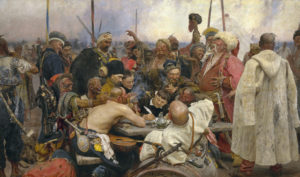The arts have assumed a prominent role in the Russian invasion of Ukraine. All over the world, the conflict has caused both individuals and institutions to recognize and help remedy some of the effects of Russian cultural hegemony over Eastern Europe. In one such change, several artists featured in the collection of New York’s Metropolitan Museum of Art had their official museum biographies changed to show that they were, in fact, Ukrainian rather than Russian. One such artist was Ilya Repin, one of the greatest painters in the nineteenth century in the Russian Empire. And now, one photographer has recreated one of his most famous paintings, bringing his work into the present day.
The Reply of the Zaporozhian Cossacks is Repin’s take on a semi-legendary incident from the late seventeenth century. According to stories, the Zaporozhian Cossacks were one of the most prominent Cossack hosts in Eastern Europe, living and operating in what is now southern Ukraine for several centuries. In the Ottoman Empire’s attempts to gain increasing control over the Black Sea, the Sultan, commonly identified as Mehmed IV, demanded that the Zaporozhians submit to his authority. In response, the Cossacks drafted a letter to the Sultan, filled with vulgar insults and profanities, expressing their intent to resist the Ottoman encroachment on their lands. Depending on the translation, the Cossacks called the Sultan a “brother and companion to the accursed Devil, and Secretary to Lucifer himself”. They also called him “thou great silly oaf of all the world and of the netherworld and, before our God, a blockhead, a swine’s snout, a mare’s ass, and clown of Hades. May the devil take thee!”
While the Ottomans did indeed try to subdue the Cossacks, the correspondence between the Zaporozhians and the Ottomans is most likely a later fabrication. Regardless, Repin shows the moment when the Cossacks draft their letter, laughing and taking great pleasure in coming up with whatever insults come to mind. The large painting, measuring 80 by 141 inches, was finished in 1891 after over a decade of work. Not long after its completion, Czar Alexander III purchased the painting. The Russian government has owned the painting ever since, with the work currently on display at the State Russian Museum in Saint Petersburg. Repin began a second, slightly smaller version, which now belongs to the Kharkiv Art Museum in eastern Ukraine, less than twenty-five miles from the border with Russia. The second version is only mostly finished, but it was Repin’s attempt at depicting the Cossacks in a slightly more authentic and historically accurate way.
The Reply of the Zaporozhian Cossacks is one of the most well-known paintings showing an episode from Ukrainian history by one of the most famous and influential Ukrainian-born artists. Yet the fact that the Russian government owns this painting has not gone unnoticed, especially recently. Keeping that in mind, the French artist Emeric Lhuisset has attempted to reclaim the painting for Ukraine. Lhuisset is primarily a photographer whose work has been exhibited across Europe. In his photograph From far away, I hear the Cossacks’ reply, Lhuisset gathered about forty Ukrainian soldiers, primarily from the 112th Territorial Defense Brigade, to re-create Repin’s painting. Though a modern re-creation, Lhuisset’s work contains many connections to the original painting, the scene it’s depicting, and the current conflict. In both the original and re-creation, we see Ukrainians resisting invasion. The fact that the re-creation features actual Ukrainian soldiers means that not only are they the heirs to the resistant spirit of the Cossacks in the painting, but some might be the literal descendants of such Cossacks. Many see the Cossacks, the Zaporozhains in particular, as one of the progenitors of Ukraine’s national heritage. They are one of the many examples of Ukraine’s status as an underdog resisting much larger forces. Even today, Repin’s image is popular and recognizable enough that even before the 2022 invasion, the internet was full of re-creations in response to Russian aggression against Ukraine. Members of Ukraine’s parliament re-created the image just less than a year before Russia’s invasion as a response to an article Putin wrote about Ukraine. As Lhuisset astutely remarked in his Instagram post, “Culture is a weapon in a vast battlefield, let’s try not to forget it.”

